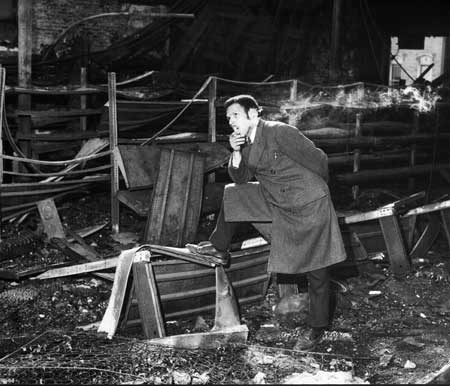
Category Archive: Pittsburgh Tribune Review
-
Landmarks Organization to Set Up CMU Fellowship
Landmarks Organization to Set Up CMU Fellowship
By Tony LaRussa
PITTSBURGH TRIBUNE-REVIEW
Thursday, July 7, 2011A local foundation that helps finance the preservation of historic structures will use a $25,000 grant to set up a fellowship program in community and economic development at Carnegie Mellon University.
The Landmarks Community Capital Corp., a subsidiary of the Pittsburgh History and Landmarks Foundation, received the grant from the PNC Foundation. The program will be established this fall at CMU’s Heinz College School of Public Policy and Management.
The fellowship will provide $4,000 yearly stipends for students to conduct research on projects of interest to Landmarks in low- to moderate-income communities, said Karamagi Rujumba, a spokesman for the organization.
The organization’s president said the fellowships will provide students studying public policy with “a great learning experience.”
“Through the Landmarks fellowship, students will get a chance to step out of the classroom, learn about our approach to community and economic development, and make a direct impact on the work we’re doing in neighborhoods and urban centers,” said Michael Sriprasert, president of Landmarks Community Capital Corp.
Sy Holzer, PNC’s regional president for Western Pennsylvania, said the fellowship program will “bring a fresh perspective to development across the region.”
-
Pittsburgh Foundation Wages War on Dilapidated Housing
Pittsburgh Foundation Wages War on Dilapidated Housing
By Kim Leonard
PITTSBURGH TRIBUNE-REVIEW
Monday, June 27, 2011
Last updated: 10:43 am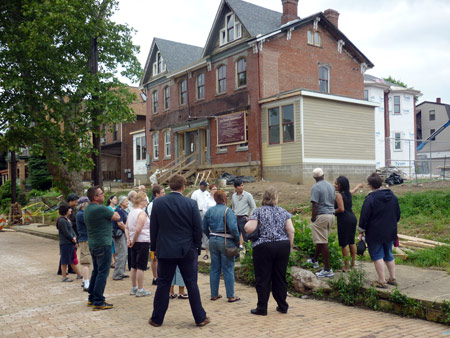
Participants of a walking tour get a look at the Wilson Building on Jeannette Street in Wilkinsburg, which is being restored by the Pittsburgh History & Landmarks Foundation and converted into rental units for low-income families. Kim Leonard | Tribune-Review
Broken glass still mars one side of the Crescent Building, which fills about one-third of a block in Wilkinsburg. But most of the windows are new, signaling that the century-old building will be ready for apartment tenants before long.
The Pittsburgh History & Landmarks Foundation led about 20 borough residents and leaders, plus others interested in how its housing restorations in the Hamnett Place neighborhood are progressing, on a walking tour after an open house on Saturday.
The century-old, red brick Crescent structure off Rebecca Avenue once contained shops and other businesses, plus apartments, but had decayed for decades. That three-story building plus an apartment house, known as the Wilson Building, on adjacent Jeanette Street are being converted to 27 rental units for low-income families, under an $8.6 million project by the foundation set for completion in the fall.
The foundation has restored and sold single-family homes and is working on three more. Its Landmarks Housing Resource Center, which opened in October in a former Packard auto dealership, is scheduling programs to advise residents of Wilkinsburg and other communities on how to maintain and improve their historic homes.
“The idea is for people to take up where we end, on their own,” said Karamagi Rujumba, with the foundation`s real estate development section.
Initial work in the neighborhood is spurring changes, said Josie Bryant, a Wilkinsburg resident and social director at St. James Church, one street away from the Crescent Building. Some Hamnett Place neighbors are adding gardens or otherwise sprucing up their homes.
A neighborhood association and church leaders, worried about abandoned, decaying buildings, approached the foundation and Allegheny County officials several years ago for help, she said. Now that some projects are being completed, “The result is that the people have an interest” in making the area better, Bryant said.
The Crescent and Wilson buildings were on a residents` list of critical buildings to be saved, said Michael Sriprasert, the foundation`s director of real estate development.
Original features such as bay windows are being kept in the Crescent and Wilson structures, and the foundation is maintaining a community garden next to the Wilson apartments site. Restorations at two homes on Holland Avenue and one on Jeanette Street should be completed in about three weeks; they`ll be sold to families that meet income limits, said Dave Farkas, director of Main Street programs for the foundation.
A total of $11.6 million in funding for projects in the borough came from the Pennsylvania Housing Finance Agency, the Scaife Foundations, PNC and Allegheny County.
-
Preservationists Praise Rehab Plan for Old Morgue
By Craig Smith, PITTSBURGH TRIBUNE-REVIEW
Friday, March 11, 2011http://www.pittsburghlive.com/x/pittsburghtrib/lifestyles/s_726879.html
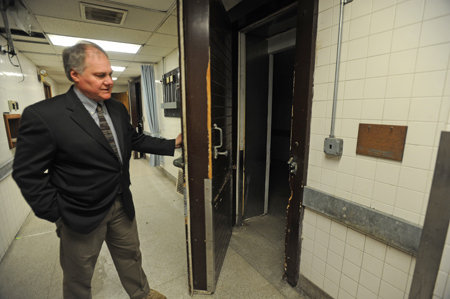
Sam Taylor, principal architect/building manager for Allegheny County department of public works, gives a tour of the old Allegheny County Morgue before it undergoes a $4 million renovation. James Knox | Tribune-Review
As a 14-year-old growing up in Oakland, Sam Taylor went to the Allegheny County Morgue at the urging of his friends to see the bodies on display.
It was a tradition for generations of Pittsburgh teens, he said. Some even took their prom dates.
“When you’re 14, you think you’re invincible,” said Taylor, 59, of Mt. Lebanon. “There was this yellowish light, and the bodies were kind of leaned back.”
Taylor, the county’s principal architect/building manager, is overseeing a $4 million renovation of the former morgue. The building, completed in 1903, was moved the length of a football field in 1929 to make way for the County Office Building.
Allegheny County expects to seek bids for demolition inside the building in late April or early May. That will create an additional 30,000 square feet of office space, while preserving many of the building’s unique features. The plan is to reuse transoms, stair railings and courtroom banisters, Taylor said.
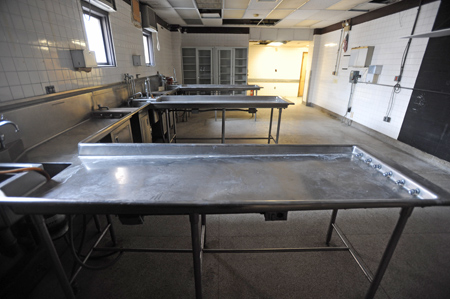
The autopsy room inside the old Allegheny County Morgue will be transformed into a new use. James Knox | Tribune-Review
A $900,000 project that included installing a terra cotta roof and masonry work was completed in 2006.
Officials haven’t determined who will use the space.
“We have a number of departments using leased space, including the Law Department and Economic Development,” said county spokesman Kevin Evanto.
Architect Paul Apostolou, who made a trip to the morgue when he was in high school, said a big part of the project will be undoing the “sledgehammer and hacksaw” approach to renovations over the years.
Preservationists praise the effort.
“I think they are trying to treat it very well for a building that no longer suits its original purpose because of modern technology,” said Arthur Ziegler, president of Pittsburgh History & Landmarks Foundation. “It’s a notable building in the government complex.”
The city designated the Frederick Osterling-designed building as a Pittsburgh landmark in 2002. Osterling, one of Pittsburgh’s premier architects, designed the county jail expansion of 1904 and Union Arcade (1915-17), which became Two Mellon Bank.
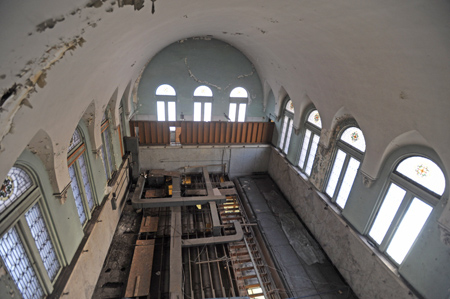
The "chapel" of the vacant old Allegheny County Morgue Friday was a place of prayer in a somber place. James Knox | Tribune-Review
The morgue building was designed to visually match the jail and courthouse, but by 1929, county government needed more space, according to a history of the building compiled by History & Landmarks. Officials decided a consolidated office building on Ross Street between Forbes and Fourth avenues would be the most efficient. That forced them to relocate the morgue.
The move was an enormous undertaking that took about three months. Work inside the building by the coroner and his staff continued without interruption, though. Temporary gas, water and sewer lines were connected and maintained on a 24-hour basis.
Huge timberwork and steel rails were used to move the building, which had to be lifted to the same height at the same moment. That ticklish maneuver was carried out by 100 men from a Balkan tribe — specialists in moving buildings from the “old country.”
They manned screw jacks that they gave a quarter turn every time a whistle sounded, until the three-story building was 27 feet in the air. It then was moved onto a system of beams designed by Kress-Oravetz Co. and slowly, laboriously pulled by cable to the foundation at 542 Fourth Ave.
Once there, Taylor said, they had to “shoehorn” the building between two structures.
In 2005, voters approved a referendum that eliminated the coroner as a row office, returning it to its early roots as an appointed position, now called medical examiner. The medical examiner’s office relocated in 2009 to a building in the Strip District.
-
Pittsburgh Development Group’s New Chief Has Big Ideas
By Craig Smith
PITTSBURGH TRIBUNE-REVIEWPittsburgh Development Group’s New Chief Has Big Ideas
Saturday, February 19, 2011
Michael Sriprasert had an exciting week.
He got engaged to his girlfriend, Gladys Perez, 32, of Bloomfield, and was named president of Landmarks Community Capital Corp., the financing division of Pittsburgh History & Landmarks Foundation.
“It’s been a heck of a week,” said Sriprasert, 30, of Bloomfield.
Sriprasert, who has been with the foundation for about five years, will retain his title and duties as director of real estate development. Wearing two hats is nothing new.
“I’m used to it. It’s not out of my skill set,” he said. “I like to keep busy.”
A 2005 graduate of the Heinz School of Public Policy and Management at Carnegie Mellon University, he is completing a Master of Business Administration degree at the university’s Tepper School of Business.
At Landmarks Community Capital, he’ll oversee about $8 million in assets. The agency funds four to six large projects a year, something Sriprasert hopes to see increase.
“I want to raise the deal flow … we’re going to be ramping it up,” he said.
He will push for Landmarks to win a Community Development Financial Institutions Fund designation from the U.S. Treasury Department. The application is pending.
The CDFI Fund certifies organizations to provide financing and related services to communities and populations that lack access to credit, capital and financial services. The designation would open the door for more money to flow into the region for preservation and other projects.
“I’m excited. … It will further the mission of Landmarks,” Sriprasert said.
The CDFI designation will “elevate the image of our work with banks and financial institutions and make us eligible for Treasury support,” said Arthur P. Ziegler Jr., president of Pittsburgh History & Landmarks Foundation.
The foundation formed Landmarks Community Capital in 2007 to provide investment capital, development expertise and pre- and post-technical assistance to low- and moderate-income communities during the early stages of development.
A substantial amount of funding for the startup came from Dick Scaife, owner of the Tribune-Review, Ziegler said.
The Sarah Scaife and Allegheny foundations gave more than $500,000, he said.
-
New Book Helps Fans Trace Steps of August Wilson
By Alice T. Carter, PITTSBURGH TRIBUNE-REVIEW
Tuesday, February 22, 2011New Book Helps Fans Trace Steps of August Wilson
A new book published by the Pittsburgh History & Landmarks Foundation offers a guide to playwright August Wilson’s world in fact and fiction.
August Wilson poses for a portrait at Yale University in New Haven, Conn., in this April 7, 2005, file photo. Wilson, whose epic 10-play cycle chronicling the black experience in 20th-century America included such landmark dramas as "Fences" and "Ma Rainey's Black Bottom," died Oct. 2, 2005, of liver cancer. He was 60. AP Photo/ Michelle McLoughlin
Published in softcover and conveniently sized for touring, “August Wilson: Pittsburgh Places in His Life and Plays” (Pittsburgh History & Landmarks, $8.95) guides visitors to sites in the Hill District and the greater Pittsburgh area connected with the playwright’s life and in his plays.
The fourth in a series of guidebooks from Pittsburgh History & Landmarks, it contains essays on the life and work of Wilson and the history of the Hill District, as well as summaries of the 10 plays in Wilson’s Pittsburgh Cycle, many of which were set in the Hill District. Wilson’s niece, Kimberly C. Ellis, and Sala Udin, Wilson’s lifelong friend, contributed introductory essays.
In addition, the book contains maps and descriptions that take visitors on a walking tour past locations that have connections to events in Wilson’s life or to the characters and settings in his plays.

August Wilson lived above this market at 1727 Bedford Avenue, in the Hill District, as seen here in this photo dated July 11, 2007. Published in softcover and conveniently sized for touring, "August Wilson: Pittsburgh Places in His Life and Plays" (Pittsburgh History & Landmarks, $8.95) guides visitors to sites in the Hill District and the greater Pittsburgh area connected with the playwright's life and in his plays. Philip G. Pavely | Tribune-Review
The goal of the book was to give the public a way to connect with those events and locations in Wilson’s life and plays, says Laurence A. Glasco, associate professor of history at the University of Pittsburgh. He co-wrote the book with Christopher Rawson, a member of the University of Pittsburgh English department and senior theater critic at the Pittsburgh Post-Gazette.
“It gives them a chance to actually walk and see and have physical and emotional contact,” Glasco says. “Something emotional happens when you walk in the feet of places where things happened. … It makes people aware of their environment, to be able to connect with that and see how it fits into a larger pattern.”

The Hill District as it appeared in 1951, when Wilson was 6 years old. The view is up Forbes Avenue from Soho. The then-new Terrace Village housing on the hilltop contrasts with older houses below. Carnegie Library of Pittsburgh
The authors began work on the book last summer. But both have been researching and thinking about the material far longer. Glasco teaches a course in the history of Black Pittsburgh at Pitt and Rawson teaches a course on Wilson’s plays.
Even so, there were surprises for the authors as they worked on the book.
“The book’s abundant photos illustrate locations that are still standing, such as the house where Wilson lived until he was 13 as well as West’s Funeral Home and Lutz’s (Meat) Market, locations that were mentioned in his plays,” Glasco says.
“I was surprised how much was there, how many places have a story that is fascinating and important and how much has been lost,” he says. “It shows how Wilson was aware of these places. … They resonated somehow in his mind and heart.”
From 1 to 3 p.m. Saturday, Pittsburgh History & Landmarks will celebrate the book’s publication with a reception and signing at the Ebenezer Baptist Church in the Hill District.
The authors will speak and books will be available for purchase.
-
Fairview Park Gets Historical Status
By Richard Robbins
TRIBUNE-REVIEW
Wednesday, February 16, 2011Fairview Park Gets Historical Status
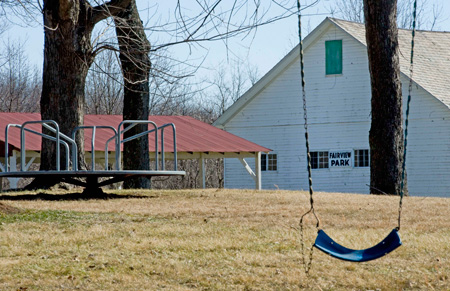
Once home to amusement rides and a swimming pool, Fairview Park today consists of aging swings sets and slides, a basketball court, a ball field and several picnic pavilions. Barry Reeger | Tribune-Review
A Westmoreland County park with roots deep in African-American history has been listed on the National Register of Historic Places and named a historic landmark by the Pennsylvania Historical and Museum Commission.
Fairview Park in Salem Township, near Delmont, was created in 1945 in response to mostly or exclusively whites-only amusement parks throughout Western Pennsylvania.
The segregationist era began to crumble in the 1960s, and the amusement rides and other attractions at the park eventually were dismantled. Today, Fairview Park consists of aging swings sets and slides, a basketball court, a ball field and several picnic pavilions.
Ernest Jackson, president of the Fairview Park Association, said the state and federal designations were intended foremost to “honor the memory” of the men and women who founded the park and of the wonderful times the park made possible.
Originally organized by a coalition of black churches in Pittsburgh, Fairview Park hosted large gatherings until sometime in the 1970s, Jackson said.
The founders had “foresight and vision,” said Jackson, of the South Hills.
“Fairview Park enabled a lot of people, including a lot of young people, to get out of the inner city and spend time in the country,” he said.
He said photographs from the late 1970s show row after row of buses jammed with fun-seekers pulling up to the park entrance.
At the height of its popularity, the park featured a roller-coaster, merry-go-round, skating rink and swimming pool.
At 52 acres, today’s park is nearly half the size it once was. It is maintained by a small group of volunteers, Jackson said.
Each summer, the Fairview Park Association holds an annual Old-Fashioned Picnic at the park with a petting zoo and other amusements. The event is open to all, Jackson said.
The de facto segregation of blacks was a way of life in the northern United States during most of the 20th century. Blacks in Western Pennsylvania were routinely barred from public facilities such as movie theaters and swimming pools. All of this was in contrast to the Jim Crow segregation — mandated by state and local laws — practiced in the South.
Carol Lee, the state’s national register and survey coordinator, said Fairview Park is the only black amusement park in the state. “At least it’s the only one we know of,” she said.
That makes Fairview Park significant in the commission’s eyes, Lee said.
The state and federal actions recognizing the park were wrapped up in December, Lee said. The review process took about 18 months.
“Basically, it’s a matter of having bragging rights,” Lee said of the designation as a state and federal historical treasure.
There are no bars to private development of the property, she said. At one time, the park association was looking forward to the construction of a multimillion-dollar, assisted-care living facility on the property.
Jackson indicated that no project is planned, though he holds out hope the park’s enhanced status will stimulate interest in the park’s history and possibly development.
-
Plans Revealed for Ex-Fayette Hospital Site
By Richard Gazarik, TRIBUNE-REVIEW
Wednesday, February 16, 2011An Allegheny County development firm plans to build a medical facility and student housing at the site of the former Brownsville Tri-County Hospital in Fayette County, a company official disclosed.
Falck Properties of Bethel Park said Tuesday that plans include an urgent-care facility, blood lab, senior citizen center, and a restaurant and cafeteria.
Spokeswoman Karen Frank said the housing will be for upperclassmen and graduate students who attend nearby California University of Pennsylvania in Washington County.
The company is not affiliated with the school, university officials said last week.
The Fayette County Planning Commission last week unanimously recommended a zoning change that will allow development of the 27-acre site. A public hearing on the zoning change will be March 24 in Uniontown, a planning commission clerk said.
The hearing occurs two days before a bankruptcy court-imposed deadline to complete the sale to Falck in order to avoid a sheriff’s sale of the property.
A bankruptcy court judge gave Falck until March 26 to complete the transaction. Parkvale Bank, which is owed $1.2 million, wants to sell the property to the highest bidder but agreed to delay the sale to give Falck time to obtain financing.
“We are hoping that the Falck Properties will create a stable tax base for Redstone Township and will lead to additional opportunities for other land and business owners,” Frank said.
Falck is paying $1.8 million for the property and has submitted $180,000 in hand money, which will be forfeited if the sale is not completed, according to a court order.
The sale hit a snag when it was discovered that the property was misadvertised as zoned for commercial use when its actual zoning classification is residential. That error has prevented Falck from obtaining financing for the project.
Brownsville Hospital closed in 2006 because it was losing money. Another group of investors reopened the hospital but could not make the facility profitable.
Since then, community leaders searched for ways and the financial means to restart a hospital but have not been successful.
-
Historic District Building’s Wall Collapses in South Side
By Margaret Harding
PITTSBURGH TRIBUNE-REVIEW
Tuesday, February 15, 2011Historic District Building’s Wall Collapses in South Side
Francine Mykich was preparing S&S Candy and Cigar Co. for its busiest day of the week when she thought she heard a truck hit the South Side store.
“We came in just like a normal Monday morning, and then all of a sudden ka-boom,” said Mykich, who has worked at the business on East Carson and South 21st streets for 26 years. “We came outside, and it’s been steadily crumbling.”
A wall of the building, which dates to 1892, collapsed onto 21st Street about 8:40 a.m. Rubble covered the sidewalk and part of the street. All the employees safely evacuated the building, and no one was injured.
“The time of day was very fortunate,” Mykich said. “We weren’t open yet, thank God.”
The collapse likely was caused by moisture freezing between layers of brick and breaking the bonds between them, said John Jennings, the city’s interim building inspection director. When the bricks thaw, there’s nothing left holding them together, he said.
The owner of the building, identified in property records as Richard Stephens, has to get an engineer to stabilize the building before clean-up begins, Jennings said. Bricks and pieces of the building continued to fall throughout the morning. Through employees, Stephens declined to comment.
It could take a day or more to stabilize the building, Jennings said.
The building is part of the East Carson Historic District. It first appeared as Armour & Company Wholesale Meats in 1892, said Frank Stroker, assistant archivist with Pittsburgh History & Landmarks Foundation.
“It was probably their main facility at that point,” Stroker said.
Armour held the location until 1952. The building then briefly became home of Freezer Foods Inc., Stroker said. By 1956, Brinn’s China and Glassware moved in, he said, and held the spot until S&S took over in 1965.
City officials would have to approve any demolition, alterations or repairs because of its location in the historic district, said John Martine, an architect and member of the local advisory committee to the city’s Historic Review Commission.
Martine said he’s always admired a canopy along the side of the building. The collapse destroyed the canopy.
“It was a very simple, but interesting canopy with wonderful wood brackets that went the length of the loading docks,” Martine said. “It’s a very working-type building. It’s not that fancy, but there’s enough detail there that it would be a loss to see the building go.”


